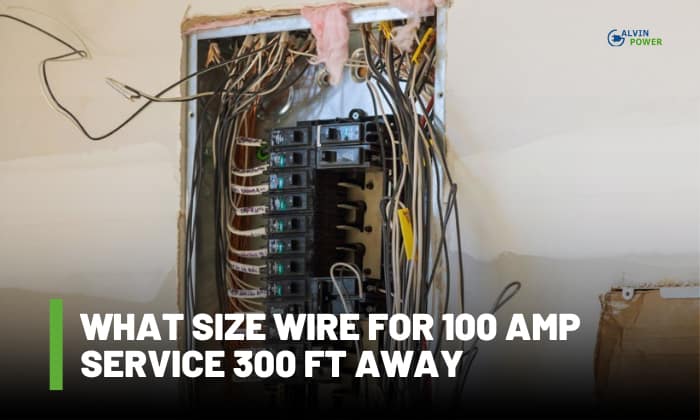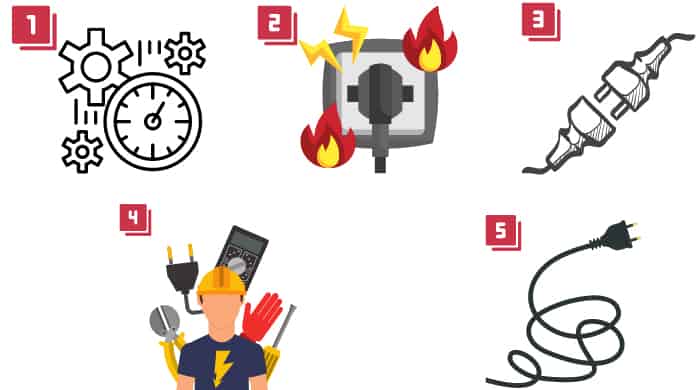100 amp service is typical for small houses with mostly gas appliances. Even though this amperage is the minimum required by code, it still needs proper planning to be safe, especially in temporary installations that are 300 feet away.
To know what size wire for 100 amp service 300 ft away, we need to consider the ampacity and the voltage drop. We can use at least a 1/0 gauge aluminum wire or 3 gauge copper wire.
Table of Contents
Wire Size Chart
Here is a chart that shows the wire sizes for short runs at 100 amps for both copper and aluminum:
| Material | Copper | Aluminum |
| Wire size from NEC Section 310.12(A) | 4 gauge | 2 gauge |
| Wire size for 300 feet up to 5% voltage drop | 3 gauge | 1/0 gauge |
Ampacity for Service Wire
For short distances, NEC Section 310.12(A) allows the use of a service wire with an ampacity of 83% of the service needed. This is only true for 100 amp to 400 amp services for dwellings if no adjustment or correction factors are required.
Let’s try to verify the aluminum wire size for a 100 amp underground wire in a single phase, 2-cable service. We need NEC Section 310.12(A) and NEC Table 310.16 for this.
First, we determine the ampacity at 83% of the service supply. Thus:
\[ \text{ampacity} = \text{service amps} \cdot 83\% = 100 \text{ amps} \cdot 0.83 = 83 \text{ amps} \]
Then, check Table 310.16 at 75⁰C to get the lowest ampacity that can handle the computed service. For our aluminum wire ampacity, this would be 2-gauge with an ampacity of 90 amps.
Here are some of the values listed from 100 amps to 400 amps:
| Service rating (amps) | Size wire for amps (AWG or kcmil) | |
| Aluminum or copper-clad aluminum | Copper | |
| 100 | 2 | 4 |
| 150 | 2/0 | 1 |
| 200 | 4/0 | 2/0 |
| 250 | 300 | 4/0 |
| 300 | 350 | 250 |
| 350 | 500 | 350 |
| 400 | 600 | 400 |
Voltage Drop for Service Wire
Aside from ampacity, voltage drops should also be considered when planning a long service wire, especially at 300 feet. Voltage drops can affect the performance of appliances and shorten their lifespan. NEC Section 310.12(A) might be fine at 50 feet but become insufficient at 150 feet and 300 feet.
Technically, the NEC has no requirement for the voltage drop for service conductors. For this, we will take a 5% voltage drop limit, similar to the maximum voltage drop of feeders and branch circuits combined.
If we want to know the underground wire size for a 100 amp service conductor that’s 300 feet away, let’s determine the voltage drop first. If the service uses aluminum wires at 240 volts, then the 5% voltage drop will be:
\[ 240 \, \text{volts} \cdot 0.05 = 12 \, \text{volts} \]
Next, we get the impedance of the wire. Impedance is technically the resistance in an alternating circuit that takes reactance into account. A simplified estimate of voltage drops would be:
\[ \text{Voltage drop (volts)} = 2 \cdot \left( \frac{\text{impedance (ohms)}}{1000 \, \text{feet}} \right) \cdot \text{current (amps)} \cdot \text{length (feet)} \]
\[ \text{impedance (ohms)} = \frac{\text{Voltage drop (volts)} \cdot 1000 \, \text{feet}}{2 \cdot \text{current (amps)} \cdot \text{length (feet)}} \]
The impedance of our 300-feet aluminum wire will be:
\[ \text{impedance (ohms)} = \frac{\text{Voltage drop (volts)} \cdot 1000 \, \text{feet}}{2 \cdot \text{current (amps)} \cdot \text{length (feet)}} = \frac{12 \, \text{volts} \cdot 1000 \, \text{feet}}{2 \cdot 100 \, \text{amps} \cdot 300 \, \text{feet}} = 0.2 \, \text{ohms} \]
Finally, we look at a resistance chart to find the conductor size that suits the impedance that we need. The most appropriate aluminum wire size will be 1/0 gauge with an impedance of 0.20.
Take note that an electrician can give you a more detailed recommendation based on both your needs and the local code in your area. Consult a licensed electrician when installing service conductors.
Factors to Consider for Wire Sizing
The main factor that affects wire sizing is the wire’s ampacity. Thicker wires can carry more current and are rated with a higher ampacity. The proper wire size should at least have an ampacity that meets your service requirements.
Several factors can affect the rating of a wire, so the wire size might be adjusted to meet the required current. Some of the factors include:
1. Material
Some materials are better conductors than others. Aluminum is less conductive than copper, so aluminum wires need to be thicker to deliver the same amount of current that copper wires can.
2. Wire installation
A wire installed in free air will have higher ampacity than a wire installed in a conduit or a bundle. When a wire is in free air, heat from the wires can be easily dissipated unlike in a conduit or in a bundle. The confined space raises the wire’s operating temperature and causes more resistance.
Of course, the conductors need to be thicker to accommodate this setup.
3. Wire insulation
Some wire insulations are more tolerant of higher temperatures than others. When resistance increases due to the higher current, more heat is released that might eventually damage wire insulation. A thicker wire with a higher ampacity can reduce the chance of damaging the insulation.
Aside from ampacity, another factor to get the right size of wire for amps we need is the voltage drop. Voltage drop increases as the wire gets longer. Using thicker wires can prevent voltage drop in longer wires, so expect to use thicker conductors for a service connection 400 ft away than at 250 feet.
Tips to Choosing the Right Wire
1. Choose the right material
Choose the material that’s right for your budget and needs. Copper wires are thinner and have better tensile strength than aluminum, but they are more expensive. Aluminum wires are cheaper and lighter than copper, but they are less conductive and more brittle than copper.
2. Choose the right insulating material
Wires have insulating materials for different purposes. For example, not all insulating materials can be used for directly burying service conductors nor are they meant for corrosive environments, so choose the one that fits your needs.
3. Choose UL-listed conductors
UL-listed conductors are tested to meet safety standards made by UL. Non-UL wires, however, may not have been tested. Choose UL-listed conductors if you can.
Common Mistakes to Avoid
Here are some common mistakes to avoid when installing wires:
- 1. The installer did not have enough planning time.
- 2. The location has too much clutter that increases fire risks.
- 3. The wires were not correctly connected to the right terminal.
- 4. The installer forgot the safety precautions when handling electricity, like wearing protective equipment.
- 5. Wires get knotted or tangled up.
Frequently Asked Questions
Can I use a smaller wire size for a 100 amp service?
No. The minimum wire size that you can use for 100 amp service is 4 gauge copper or 2 gauge aluminum. They’re listed in NEC Section 310.12(A).
What is the maximum distance for a 100 amp service without significant voltage drop?
4 gauge copper wires or 2 gauge aluminum wires can be used up to 100 feet. Use thicker wires for longer distances, like 3 gauge copper wires or 1/0 aluminum wires for 300 feet.
Conclusion
We have to check what size wire for 100 amp service 300 ft away if we are planning to install a service conductor. 1 gauge copper or 1/0 aluminum wires can minimize the voltage drop at 300 feet and have the right rating to deliver 100 amps.
Our tips for choosing the right conductor can help you with your project. But before you implement it, always consult an electrician to safely install your service wires.

I am Edwin Jones, in charge of designing content for Galvinpower. I aspire to use my experiences in marketing to create reliable and necessary information to help our readers. It has been fun to work with Andrew and apply his incredible knowledge to our content.






